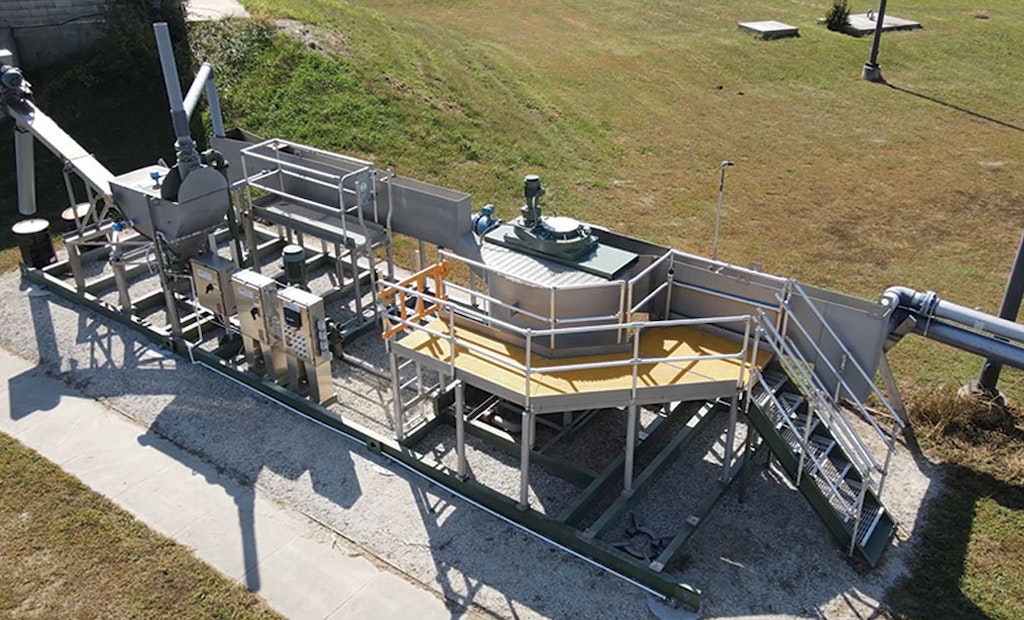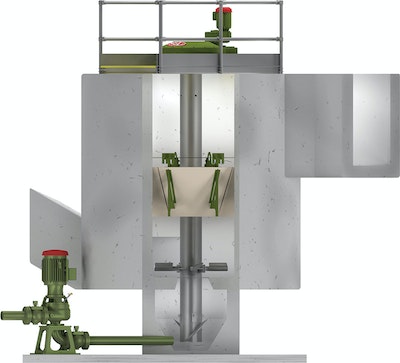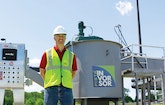
The system maintains 95% grit removal efficiency all the way through complementary grit washing and dewatering devices in a PISTAWorks packaged configuration.
Interested in Headworks?
Get Headworks articles, news and videos right in your inbox! Sign up now.
Headworks + Get AlertsGrit removal in clean-water plants is essential to effective treatment and to protecting equipment downstream from the headworks. Sand removal in potable water plants is also essential.
The challenge is to capture the widest range of grit particle sizes and do so in an efficient and reliable system. Smith & Loveless has introduced a new generation of its long-established PISTA Grit Removal system. It’s designed to remove ultra-fine particles.
The PISTA INVORSOR vortex grit system combines proven particle-capture methods. It uses enhanced settling by inclined plates that meet a defined surface overflow rate, combined with hydraulic forced vortex grit removal. The manufacturer says this process results in 95% efficient removal of ultra-fine grit down to 75-micron particles across all flows, with no derating at low, average, high or peak flows.
The system is designed to deliver low capital and operating costs, large capacity in individual units, significant design flexibility for inlet-outlet options, and a high surface-area-to-volume ratio to generate consistent fine grit capture during low flow, daily flow and peak flow conditions. Flow capacities in single units are up to 50 mgd.
Systems can be sized by flow or by a defined particle size. William Flores, Smith & Loveless vice president of the municipal products and systems division and customer service, who has served on the WEF Grit Characterization Task Force, talked about the technology in an interview with Treatment Plant Operator.
TPO: What events in the market led you to develop this technology?
Flores: The technology when we started developing this product was focused on removing 95% of 105-micron particles. We saw a drive in some geographic areas for removal of smaller particles. That is what drove the market for 95% removal at 75 microns — what we call ultra-fine particles.
TPO: Why is the market looking for more removal of ultra-fine particles?
Flores: With 75-micron particles, the abrasives issue that customers had with wearing pump impellers and damaging other downstream equipment may be less important than with larger particles like 105, 200 and 300 microns. But the 75-micron particles contribute to accumulation in downstream basins. The trend is also technology-driven, to prevent damage to membrane bioreactors, which are a relatively delicate technology.
TPO: Does this technology include elements of the established PISTA Grit system?
Flores: It is a different technology, but we retained key elements of the PISTA Grit Removal system as we developed this product. They include the vortex unit with the propeller blade, the flat-floor design, and the way the flow stream is introduced to the chamber on a tangent to create the vortex, which is an efficient way to remove the larger particles. We also kept the lower grit hopper to enable intermittent pumping.
TPO: What processes have been added for the INVORSOR technology?
Flores: To remove the 75-micron particles we needed an extra step, and that is where the inclined plates above the vortex come into play. The purpose there is to break the vortex and create a sedimentation step in more quiescent conditions. We developed this technology using computational fluid dynamics while also validating the results with an actual installation.
TPO: How would you describe the grit removal sequence for the larger particles?
Flores: After screening, the wastewater travels down an open channel to a sloped portion that feeds into the lower part of the INVORSOR unit. The flow is introduced to the unit tangentially, and when it hits the circular chamber, the grit is caught by the vortex. The larger particles are hydraulically pushed toward the center of the flat floor, pass under propeller blades that rotate at a very low rpm, and are trapped in the lower hopper. A grit pump then intermittently sends the collected grit particles to the grit washing and dewatering process.
TPO: What is the purpose of the propeller blades?
Flores: The propeller blades are designed to reject organic material; this is the first step in washing the grit. The less organics the grit contains, the better the quality of the material dumping into the hopper.
TPO: How are the finer particles then captured?
Flores: The 75-micron particles that remain in suspension will transition upward to the quiescent settling zone (similar to a clarifier). There, the particles travel between inclined parallel plates and fall to the bottom plate, where the surface tension retains them.
TPO: Once the 75-micron particles are captured by the inclined plates, how are they removed from the system?
Flores: Basically, because of the slow rotation of the propeller blades, a Coandă effect is created where the fine particles hug the center propeller shaft all the way down to the lower hopper.
TPO: Does the capture rate for 75-micron particles vary with the flow rate?
Flores: This technology provides 95% removal of 75-micron particles with no derating at higher flows. Previously when technologies were promoted for removal of 75-micron particles, you would see that at peak flow conditions they would only remove particles at 105 or 200 microns. As an added advantage, our existing grit washers and grit classifiers are also capable of handling those 75-micron particles.
TPO: What maintenance does this process require?
Flores: The drive mechanism uses a 2 hp sealed motor that needs very little maintenance. Every six months the operators should inspect the upper inclined plates to make sure no unwanted material has been trapped there. If necessary, the plates can be rinsed with nonpotable water. The inclined plates do not come in a single piece. We designed them to come out in sections. For maintenance that’s a lot easier than having to remove an entire inclined plate module.
TPO: Is this system fully automated?
Flores: It is very hands-off. Operators can monitor it from an HMI, but most prefer to do a daily walk-around as they would for any other equipment to see if anything is out of place. They also typically monitor the dump container to make sure everything is being removed properly. When a systems integrator is not necessarily part of the project and the customer wants an individual control system, we offer an in-house design called a QuickSmart with its own HMI.







